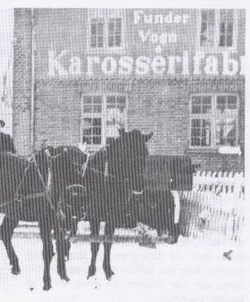 M.C. continued the manufacturing of agricultural machines. Photos from that time shows big wooden wheels for wagons without suspension. He soon built a horse wagon, priced all over the country for its skilled craftman ship. It was called the Funder Jumbe where Jumbe means wagon. The main part of the building material for the wagons were ash wood which showed to be good and strong. The wagons were shown at market places where they made good commercial for the product.
M.C. continued the manufacturing of agricultural machines. Photos from that time shows big wooden wheels for wagons without suspension. He soon built a horse wagon, priced all over the country for its skilled craftman ship. It was called the Funder Jumbe where Jumbe means wagon. The main part of the building material for the wagons were ash wood which showed to be good and strong. The wagons were shown at market places where they made good commercial for the product.
M.C. bought himself a motorcycle, a Nimbus 1921, which at one occasion acted as traction vehicle. A carriage was to be delivered, they than put a guy in the passanger seat holding the towbar and of they went!
Christensen made the impression that he was a precursor in the coachbuilding buisness. In old photos there's sowing machines shown with wooden wheels, lots of wheels with hub and spokes where only the rim and the iron along the rim is missing. The movement increased along time, manufacturing all that could be needed in coachbuilding. A new shop was built in 1928 and in 1934, when the car had entered the scene, new machinery were purchased. Mainly coaches on FORD chassis were built. The buisness now changed name to Funder Vogn og Karrosser Fabrik A/S. The wood used were ash and beechwood. No one can recall any complaints. A good mark.
A regular customer, Frode Laursen, fetched the naked chassis from Fredrikshavn from wherer they were droven the 200 kilometers to Funder. The chassis only had rubber bands on the wheels why they immediately were driven to a close by tire shop. When getting all new tires, the trip home could begin.
Along time, the cars went higher and higher. It was necessary to lift the roof on the shop. It helped for only a while 'cause the vehicles got even higher. At last, only the small apprentices who could get between the roof of the vehicle and the ceeling, got to make the vinyl stretched top of the roof.
When the cars were about to be painted, a painter from Silkeborg came. He did all the under work, working to late evening. When it was time to paint, the floor was cleaned and then he got to work. Mostly the work was done in the night.
It was forbidden to smoke inside due to all the wooden scrap. When the need appeared you went down to the very small toilet. There was no electric light but there were narrow openings in the door that let outside light in. And inside smells out... The door was subject to mischiefs. For instance could a bucket of cold water be thrown at the door. Inside you could here the strongest curse ever heard. The fun maker of course couldn't be found. The revenge therefore got out over next toilet visitor.
Occasionally the baker drove by and sold buns and cookies. An older man had a standing order for two big Napoleon cookies with cream. He put them in his lunchbox for later. His so called friends wanted to play him a joke. They removed the cream and put glue there instead. Not knowing what his friends had been up to, the old man began eating. No reaction. He ate both the cookies without a hinge of beeing mishappy. The jokers were worried but didn't reveal what had been done. Now the older man has reached the age of 80 and is living well. The jokers now can say that glue probarly not is dangerous to your health... This joke was a bit hard, mostly the jokes were only small irritating happens along the day. As putting sawdust on your buddy's sandwich.
M.C. Christian was a strict gentleman. In the mornings he stood in the door watching his pocket watch and excpected all to be in place at 07.00 sharp. A forced manner existed between M.C. and the blacksmith Juhl and saddler Frede Holm Möller. Juhl and Möller delivered some work for the factory but M.C. hold the prices down to make more money in the other end.
Erik Ravn Hansen, worker at the factory, guess that it was the caravans that put the company to rest. When competitors made easy built, cheep caravans, Funder put a lot of effort in their products. Expensive materials made the caravs astonishing but heavy. When the company was put a rest in 1977 a lot of wood still hadn't been used. It was sold to Funderholme Karosserifabrik, another coachbuilder in town.
Click the two links below to see a pickup built by Funder coachbuilder photographed outside the factory in 1955. The pictures belong to the Internet site Danske Billeder.
Funderpickup, bild 1
Funderpickup, bild 2
Information about Funder Vogn og Karrosser Fabrik A/S is fetched from the small book "Syn for Sogn 2004 - lokalhistorier fra Silkeborgegnen" written by Kurt N. Christensen. The book can be bought from Silkeborgs library in Danmark.
Published 2008-09-08